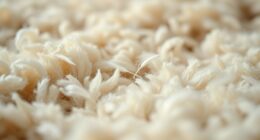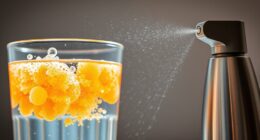Temperature swings impact silk’s tensile strength by causing the molecular bonds within its fibers to expand and contract. Heat weakens these bonds, making the silk more fragile and prone to tears, while cold causes it to become brittle and less flexible. Repeated temperature changes can deteriorate the fiber’s integrity over time. Understanding how environmental factors affect silk helps you protect its durability, and exploring more can give you effective strategies for preservation.
Key Takeaways
- Temperature fluctuations cause silk fibers to expand and contract, weakening their tensile strength over time.
- Rapid cooling or heating can disrupt molecular bonds, increasing silk’s brittleness and risk of breakage.
- Repeated temperature swings stress silk’s molecular structure, leading to reduced durability and mechanical integrity.
- Stable temperatures help maintain silk’s tensile strength by minimizing molecular bond disruption.
- Environmental controls that regulate temperature fluctuations are essential for preserving silk’s performance and longevity.
The Composition and Structure of Silk Fibers

Silk fibers are primarily composed of proteins known as fibroin, which give them their remarkable strength and flexibility. The structure of silk fibers includes a core of fibroin surrounded by sericin, a protein that acts as a natural glue. This composition influences silk’s coloration, affecting how dyes bind and how vibrant the final hue appears. During silk cultivation, factors like the silkworm’s diet and environment impact the quality and color of the silk produced. The tightly packed beta-sheet structures in fibroin create a strong yet flexible fiber, making silk ideal for various applications. Understanding the molecular makeup helps you appreciate how silk’s composition contributes to its durability and beauty, especially when considering how environmental conditions impact its overall properties. Additionally, the protein structure of fibroin is crucial in determining silk’s tensile strength and elasticity. Environmental factors such as temperature swings can also influence the fiber properties, affecting both the strength and flexibility of silk fibers. These environmental influences are essential to consider when evaluating silk’s performance in different settings. Moreover, the molecular arrangement of fibroin plays a significant role in how silk responds to external stresses and strains.
How Temperature Fluctuations Affect Silk’s Molecular Bonds
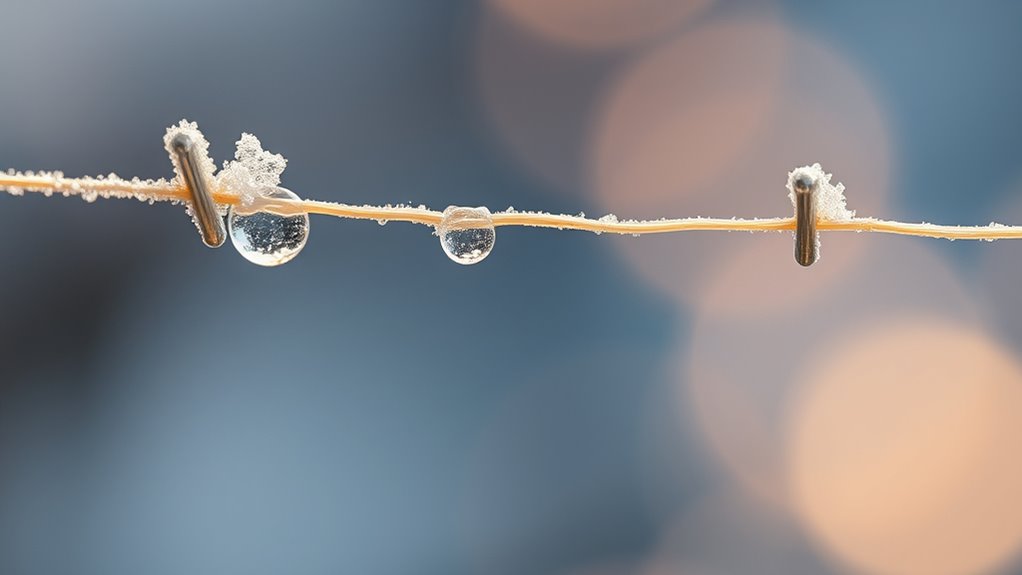
When temperature fluctuations occur, they directly impact the molecular bonds within silk fibers, influencing their strength and flexibility. As temperatures rise, thermal expansion causes the silk’s molecular bonds to stretch, weakening the overall structure. Rapid cooling can lead to molecular bond disruption, making fibers more brittle. These changes affect how silk responds to stress, reducing tensile strength and elasticity. The disruption of molecular bonds occurs because heat vibrations weaken the bonds holding amino acids together, while contraction during cooling tightens or fractures these bonds. This constant cycle of expansion and contraction stresses the bonds, compromising the fiber’s integrity over time. Additionally, environmental factors such as humidity can further influence silk’s molecular stability, amplifying the effects of temperature changes. Understanding these molecular effects helps explain why silk’s mechanical properties vary with temperature, highlighting the importance of stable conditions for maintaining silk’s durability. Proper temperature control and environmental management are crucial for preserving the silk’s structural integrity over extended periods. Moreover, research indicates that thermal cycling can accelerate degradation processes in silk fibers, emphasizing the need for controlled environments in applications requiring long-term durability. Maintaining consistent temperatures can help prevent molecular bond weakening and extend the lifespan of silk fibers.
The Impact of Heat on Silk’s Tensile Strength

Heat has a significant effect on silk’s tensile strength by weakening its molecular bonds and reducing its ability to withstand stress. When exposed to high temperatures, silk fibers become more fragile, making them prone to tearing during activities like silk embroidery. This heat sensitivity also impacts silk dyeing processes, where excessive heat can cause color unevenness or damage. During silk dyeing, controlling temperature is vital to maintain fiber integrity. Similarly, in silk embroidery, working with heated tools or environments can weaken the fabric, resulting in snags or breaks. Additionally, understanding the temperature sensitivity of silk helps you better preserve its durability and appearance. Proper temperature management ensures your silk projects stay strong, vibrant, and long-lasting. Awareness of material properties related to heat can guide better handling and preservation practices for silk. Recognizing the AI vulnerabilities that can affect manufacturing processes may also help in developing more resilient silk production techniques. Being aware of emerging automation technologies can further optimize silk manufacturing and processing methods. Moreover, considering fabric composition can influence how silk responds to temperature changes, enhancing preservation strategies.
Cold Temperatures and Their Effect on Silk Flexibility

Exposure to cold temperatures causes silk fibers to lose some of their natural flexibility, making them more prone to stiffness and brittleness. As temperatures drop, thermal contraction occurs, reducing the fiber’s ability to bend without breaking. This contraction leads to less tensile variation, meaning the silk becomes less capable of stretching under stress. Cold conditions cause the molecular chains in silk to tighten, decreasing elasticity and increasing the risk of fiber breakage when tension is applied. Over time, repeated exposure to low temperatures can weaken silk’s structure, making it more fragile. If you work with silk in cold environments, you’ll notice it becomes more rigid and less forgiving to tensile forces, compromising its durability and increasing the likelihood of damage during handling or use. Additionally, understanding the material properties of silk can help in developing better protective measures against temperature-induced deterioration. Recognizing the thermal response of silk is essential for optimizing handling and storage conditions, especially in environments subject to fluctuating temperatures. Being aware of environmental factors can also aid in preventing premature fiber failure and extending the lifespan of silk products. Furthermore, implementing appropriate storage techniques can mitigate the adverse effects of cold exposure on silk’s tensile strength.
The Role of Humidity in Temperature-Related Silk Weakening

Humidity levels play a vital role in how temperature affects silk strength. When moisture fluctuates, it can weaken fibers and reduce durability. Managing humidity is key to maintaining silk’s tensile integrity in changing conditions.
Humidity’s Effect on Silk
While temperature fluctuations can weaken silk fibers, humidity plays an equally crucial role in this process. High humidity levels can cause silk to absorb moisture, making fibers more flexible but also more vulnerable to weakening over time. Conversely, low humidity dries out the silk, leading to brittleness and increased risk of breakage. During silk dyeing, inconsistent humidity can affect dye absorption and color vibrancy, impacting the final result. Similarly, silk weaving techniques are sensitive to humidity, which influences thread tension and fabric integrity. Maintaining ideal humidity ensures the silk remains strong and manageable throughout production and storage. Proper humidity control helps preserve tensile strength, reducing the chances of fiber damage caused by moisture-related fluctuations.
Moisture and Fiber Strength
When temperature fluctuations occur, moisture levels in silk fibers directly influence their strength. As humidity rises or falls, silk’s moisture content changes, affecting its tensile strength. During silk dyeing, controlling moisture is vital; excess moisture can weaken fibers, leading to uneven coloring or damage. Similarly, in silk weaving techniques, inconsistent humidity can cause fibers to become brittle or overly pliable, risking breakage during process adjustments. Maintaining ideal moisture levels ensures silk remains resilient under temperature swings. When moisture is balanced, fibers maintain their tensile strength, preventing damage caused by drying out or swelling. Understanding this relationship helps you better manage silk’s durability, especially when exposed to varying environmental conditions. Proper handling of moisture is essential for preserving silk’s integrity across all stages, from dyeing to weaving.
Managing Humidity Levels
Maintaining proper humidity levels is essential because fluctuations can considerably weaken silk fibers during temperature changes. When humidity drops or rises unexpectedly, silk becomes more vulnerable, especially during processes like silk dyeing and weaving. Controlling humidity helps preserve fiber strength and prevents damage caused by expansion or contraction.
- Keep humidity between 50-60% to protect silk during storage and handling
- Use humidifiers or dehumidifiers to stabilize environmental conditions
- Avoid exposing silk to rapid temperature swings that alter moisture levels
- Proper humidity management ensures smoother silk dyeing and more durable woven fabrics
Comparing Silk’s Performance in Stable vs. Fluctuating Climates
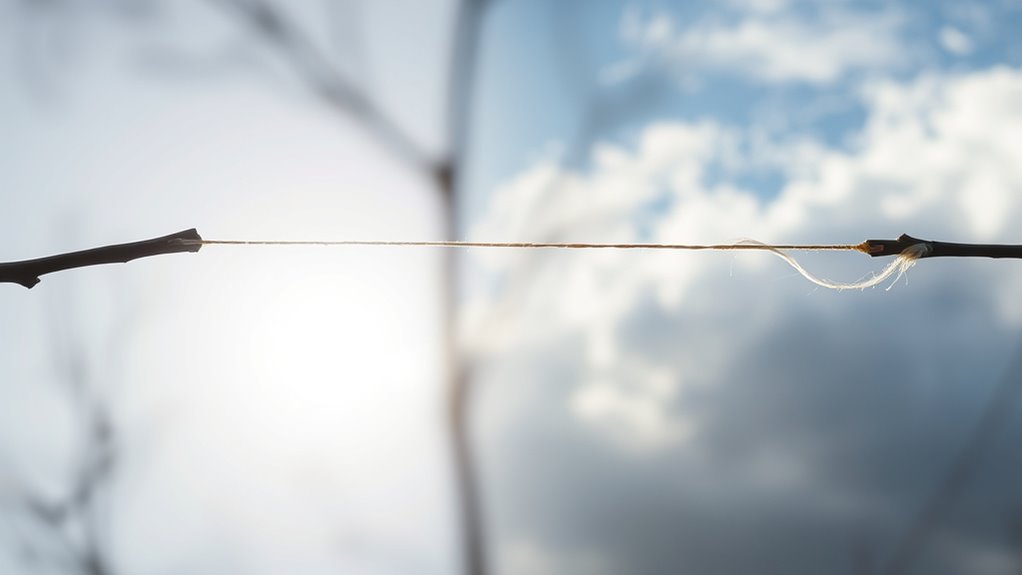
Silk’s performance varies markedly depending on environmental stability, with fluctuating climates posing unique challenges. In unstable conditions, temperature swings can cause silk fibers to expand and contract, weakening their tensile strength over time. During silk dyeing, temperature fluctuations may lead to uneven color absorption or fading, affecting the final appearance. In silk weaving, inconsistent temperatures can make fibers more prone to breakage, reducing fabric quality. Stable climates help maintain the fiber’s integrity, ensuring consistent tensile strength and vibrant dye results. Conversely, fluctuating environments demand careful handling and adjustments in processing techniques. Understanding these differences allows you to optimize silk’s durability and appearance, ensuring that whether in dyeing or weaving, the fabric maintains its strength despite temperature variations.
Testing Methods for Assessing Silk’s Tensile Strength Under Varying Temperatures

To accurately assess silk’s tensile strength under different temperature conditions, researchers employ specialized testing methods that simulate real-world environmental fluctuations. These tests help determine how silk performs when exposed to temperature swings, considering factors like biodegradability concerns and aesthetic considerations. You’ll find that:
- Dynamic tensile testing exposes silk to cyclic temperature variations to observe strength changes.
- Thermomechanical analysis measures elasticity and deformation at different temperatures.
- Environmental chambers replicate fluctuating climates, testing silk’s durability.
- Data from these tests inform material selection based on strength retention and aesthetic integrity.
Practical Implications for Silk Use in Different Environments

Understanding how temperature affects silk’s strength helps you choose the right material for your environment. Moisture and flexibility also influence durability, so knowing these factors guarantees your decisions. Adapting silk to different conditions ensures it performs reliably and lasts longer in your specific setting.
Temperature Effects on Strength
Temperature fluctuations can markedly influence silk’s tensile strength, affecting its performance in various environments. When exposed to high heat, silk undergoes thermal expansion, which can weaken its fibers over time. Conversely, cold temperatures can make silk more brittle, increasing the risk of breakage. Elevated temperatures may accelerate chemical degradation, breaking down the protein structure and reducing strength. Understanding these effects helps you choose the right silk for specific conditions.
- High temperatures induce thermal expansion, weakening fibers
- Cold environments increase brittleness and fracture risk
- Elevated heat accelerates chemical degradation of silk proteins
- Proper temperature regulation extends silk’s durability and strength
Moisture and Flexibility Impact
Moisture levels considerably influence silk’s flexibility and durability in various environments. When humidity is high, silk absorbs moisture, making it more supple and easier to handle during silk weaving techniques. Conversely, low moisture can cause silk to become brittle and prone to cracking, especially when subjected to tension. For silk dyeing, controlling moisture is essential to achieve even color absorption and prevent uneven patches. In different environments, adjusting moisture content ensures silk maintains its tensile strength and flexibility. If you’re working with silk in humid conditions, keep in mind that excess moisture might weaken the fibers over time, while in dry settings, additional moisture can help preserve thread integrity. Understanding these moisture impacts allows you to optimize silk’s performance and longevity in your projects.
Environmental Adaptation Strategies
Adapting silk use to different environments requires practical strategies to maintain its strength and flexibility. To optimize silk’s performance across varying conditions, consider methods that enhance thermal insulation and chemical resistance. For cold environments, treat silk with insulating compounds or blend it with other fibers to retain warmth. In chemical-rich settings, apply protective coatings that boost resistance without compromising flexibility. Adjusting silk’s exposure to extreme temperatures helps prevent deterioration. Proper storage in controlled environments extends its lifespan. Additionally, selecting silk variants designed for specific conditions can improve durability and functionality. These strategies ensure silk remains resilient, whether used in hot, cold, or chemically intense environments. By implementing these adaptation techniques, you maximize silk’s potential while preserving its tensile strength.
Strategies to Protect Silk From Temperature-Induced Damage

To effectively safeguard silk from temperature-induced damage, you need to implement specific protective strategies. First, consider how silk dyeing methods can impact thermal stability; choosing dyes that bond well minimizes color fading and structural weakening. Additionally, employing gentle silk weaving techniques reduces stress on fibers during production, making the fabric more resilient to temperature fluctuations. Proper finishing treatments, like applying heat-resistant coatings, can further shield silk from sudden temperature swings. Store silk in climate-controlled environments to maintain consistent temperatures and humidity levels. When handling or cleaning your silk, avoid exposing it to high heat or rapid temperature changes. These measures help preserve the tensile strength of silk fibers, ensuring longevity and maintaining its delicate, luxurious qualities despite environmental challenges.
Future Research Directions on Silk Durability and Environmental Factors
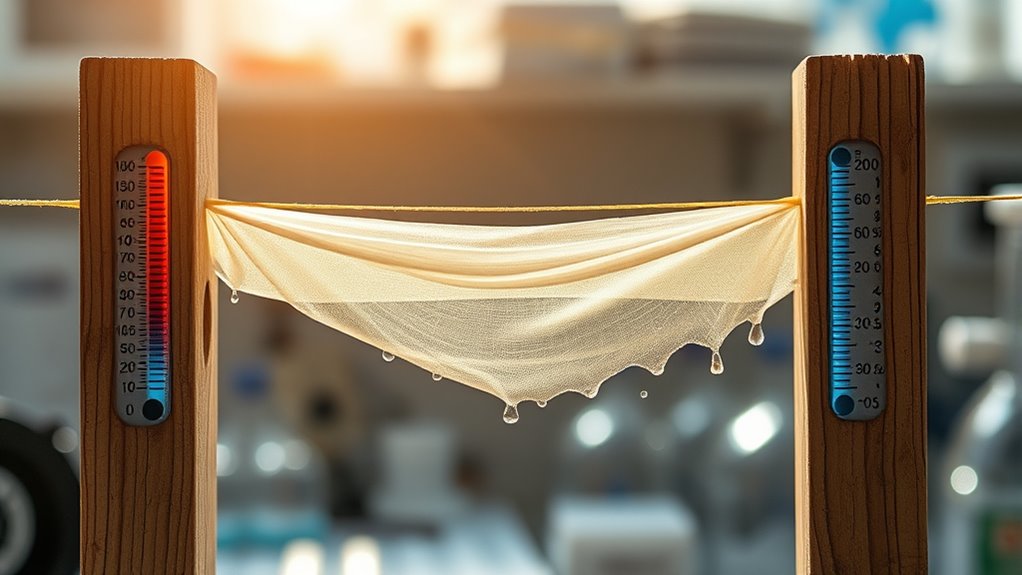
Future research on silk durability and environmental factors should focus on understanding how various conditions, such as temperature fluctuations, UV exposure, and pollution, directly affect fiber integrity over time. You can explore how genetic modification might enhance silk’s resilience against these stresses. Enzyme treatments could also play a role in repairing or strengthening damaged fibers caused by environmental factors. Investigating how these approaches influence tensile strength and longevity will be critical. Additionally, studying the combined effects of multiple environmental stressors can reveal vulnerabilities and guide improvements. Future work should aim to develop silk variants better suited for diverse climates and applications. Ultimately, understanding these interactions will help create more durable silk products capable of withstanding the rigors of real-world environments.
Frequently Asked Questions
How Does Prolonged Exposure to Temperature Extremes Affect Silk Longevity?
Prolonged exposure to temperature extremes can markedly reduce silk’s longevity by causing thermal degradation. You might notice decreased tensile durability, making the silk fibers more prone to breaking and weakening over time. High heat accelerates fiber deterioration, while cold can make silk brittle. To maintain silk’s strength and longevity, avoid exposing it to extreme temperatures for extended periods, as this accelerates degradation and shortens its lifespan.
Can Silk Be Engineered to Resist Temperature Fluctuations Better?
You can engineer silk to better resist temperature fluctuations through biopolymer modifications aimed at thermal stabilization. By incorporating specific additives or crosslinking agents, you enhance silk’s resilience against heat stress. These modifications strengthen the silk’s molecular structure, making it less prone to degradation caused by temperature changes. As a result, your silk products will last longer and maintain their properties even in fluctuating environments.
What Are the Best Storage Conditions to Preserve Silk Quality?
To preserve silk quality, you should store it in a cool, dry place away from direct light and humidity fluctuations. Use humidity control to maintain consistent moisture levels, preventing silk from becoming brittle or moldy. Keep silk in breathable storage like cotton or silk pouches, and avoid plastic containers that trap moisture. By controlling light exposure and humidity, you guarantee your silk remains soft, shiny, and strong over time.
How Do Natural Silk Fibers Compare to Synthetic Ones in Temperature Resilience?
You’ll find natural silk fibers are more sensitive to temperature changes than synthetic ones. They have better fiber elasticity at stable temperatures, which helps them resist breakage, but extreme heat can weaken them. Synthetic fibers, however, handle temperature fluctuations better, maintaining dye retention and strength. So, if you’re concerned about temperature resilience, synthetic options might be more durable, while natural silk offers superior elasticity and vibrant dye retention under consistent conditions.
Are There Any Treatments That Enhance Silk’S Heat or Cold Resistance?
You can enhance silk’s heat or cold resistance using chemical treatments or thermal coatings. Chemical treatments often involve applying specialized agents that improve silk’s stability under temperature fluctuations, making it more durable. Thermal coatings create a protective barrier, helping silk resist extreme temperatures. These methods are effective, but you should consider potential impacts on silk’s natural properties and appearance before applying them.
Conclusion
As you explore silk’s delicate dance with temperature changes, you’ll discover how gentle shifts can subtly influence its strength and flexibility. By understanding these nuances, you can better safeguard and preserve this exquisite material in various environments. With mindful care and thoughtful strategies, you’ll ensure silk continues to shimmer gracefully, maintaining its beauty and resilience through the ebb and flow of nature’s subtle whispers.






